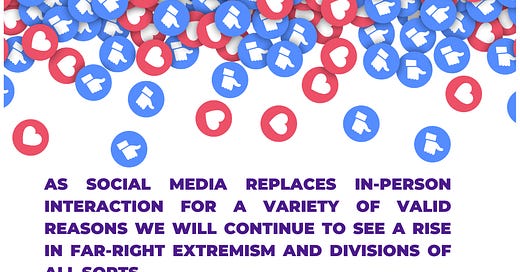Listen, I love social media. I especially love TikTok, although I don’t post on that app anymore. I love the Day in the Life vlogs of individuals showing their work day in the office, I love the little skits people make, I love listening to music put forth by people who haven’t yet achieved any measure of fame, and I love the edits to tv shows. Right now my for your page is filled with thirst edits of the salesman and the frontman from the Squid Games.
But like any product, social media has its drawbacks: it can be a time sucker, it can be a way to promote materialism and unfettered capitalism, and more importantly, it provides a wide audience for various forms of hate. There have been numerous articles about how social media can contribute to the rise of multiple forms of extremism including the types that elected the incoming US president or that inspired the January 1, 2025 attack in New Orleans.
Social media can also foster various forms of division. Smarter people than me can theorize why but I have my ideas. Not only does social media give a false sense of anonymity to faceless bullies, but it supports groupthink and it endorses the idea that the people we view on social media are not humans but rather products to be consumed. Social media has taken the level of scrutiny that used to be reserved for celebrities and other famous figures and made it available to everyday people.
To be sure, that isn’t always a bad thing. Social media can make large numbers of people aware of injustices and corruption that in the past would have remained hidden and ignored. But social media also creates an alternative reality where those on camera are always flawed and the viewer is perfect and above reproach. It also, not surprisingly creates an echo chamber that distorts reality. Now, I firmly believe that echo chambers aren’t always bad. They can provide safety for marginalized groups in a hostile society. But they can also amplify hatred and hostility.
I am particularly concerned about the echo chamber of religious belief that social media, especially TikTok amplifies. For example, anyone who knows me knows that for better or worse, I show no loyalty to any particular Christian denomination. I attend the most progressive church that is easily accessible to me in the area that I live in. I just so happen to now live in a relatively small city in Georgia so my options are fairly limited as the Episcopal church in the area has a handful of members that regularly attend and it isn’t actually particularly progressive. And the churches that may be part of Mainline Protestant denominations are Evangelical in practice.
As a result, I am currently attending a Roman Catholic Church. To be sure, there is a lot I disagree theologically and politically with the Roman Catholic Church-not a fan of closed communion, their closing of the deaconship and priesthood to women, their pro-life stance that seeks to limit access to abortion and birth control not only for those who identify as Catholic but for all, and their treatment of queerness as a sin. But my experience with Catholicism has been that there is a wider breadth and diversity between what is official church teaching and the lived experiences of many individual Catholics.
I have met not only lay members of the church, but priests and others in religious life who advocate for a separation between church and state-especially when it comes to reproductive rights. They are pro-choice in the sense that they believe that only individuals should be able to decide the number of children they want if they want any at all. I have also met lay, people and leaders, who advocate for women priests and deacons and who are openly queer. Even in places where priests and leaders aren’t necessarily progressive, the reality of day-to-day life is much more…ordinary. Unless the priest and congregation fall on the more far right side of the political and theological spectrum, day to day services are focused less on politics and more on the daily struggles and joys of the congregation.
But on social media the complicated reality of the interconnection between faith and daily life is ignored. If I went by what Tiktok’s algorithm determined was representative of Catholicism it would be reactionary conservatism and radical traditionalism with of course a dash of anti-Protestantism. And then of course, if I tried to get a grasp of a fair representative of Protestantism, It would be the radically conservative denominations. (To find the more progressive denominations I’d have to specifically look up Progressive Christianity).
This distortion of reality, tied to a lack of critical thinking and an inability to do research contributes to the idea that the only voices of faith that are “true” and worth listening to are in the far right. And as social media replaces in-person interaction because of a lack of free third spaces, lack of public transportation, people working long hours and not having the time or physical ability to meet, we will continue to see a rise in far-right extremism and divisions of all sorts. I don’t believe social media is “bad” and I have major qualms about the potential TikTok ban. However, I also express concern with how social media is utilized and the often monolithic representation of Christianity it presents.
Image: a bunch of thumbs-up icons and heart icons on the top and bottom of the image. Text: As social media replaces in-person interaction for a variety of valid reasons we will continue to see a rise in far-right extremism and divisions of all sorts.



